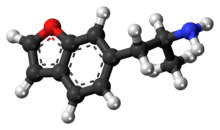6-APB
 | |
 | |
| Systematic (IUPAC) name | |
|---|---|
|
6-(2-aminopropyl)benzofuran | |
| Clinical data | |
| Legal status |
|
| Identifiers | |
| CAS Number |
286834-85-3 |
| ATC code | None |
| PubChem | CID 9794343 |
| ChemSpider |
7970110 |
| Chemical data | |
| Formula | C11H13NO |
| Molar mass | 175.23 g/mol |
| |
| |
| | |
6-(2-aminopropyl)benzofuran or 1-benzofuran-6-ylpropan-2-amine (6-APB), also known as Benzofury, is an entactogenic compound of the phenethylamine and amphetamine classes. It is a recreational drug that is similar in structure to MDA, but differs in that the 3,4-methylenedioxyphenyl ring system has been replaced with a benzofuran ring. 6-APB is also the unsaturated benzofuran derivative of 6-APDB. While the drug never became particularly popular, it briefly entered the rave and underground clubbing scene in the UK before its sale and import were banned.
Pharmacology
6-APB is a triple monoamine reuptake inhibitor with Ki values of 117, 150 and 2698 nM for NET, DAT and SERT respectively as well as being a potent agonist for the 5-HT2B receptor (Ki 3.7 nM).[1] The subjective effects and structure–activity relationship suggest that it is also a releasing agent.
The agonism for 5-HT2B makes it likely that 6-APB would be cardiotoxic with long term use, as seen in other 5-HT2B agonists, such as fenfluramine and MDMA.[1][2] 6-APB acts as an agonist of the 5-HT2C receptor,[3] which may be responsible for its appetite suppression. While 6-APB is an agonist at all three 5-HT2 receptor subtypes, its affinity for 5-HT2B is significantly higher. It is both more potent and more selective over other serotonin receptors than the reference agonist, BW723C86, which is commonly used for research into 5-HT2B receptors.
Reactions
6-APB succinate reacts with the marquis reagent to give a deep indigo purple, almost black in concentrated areas after 10 seconds. There is some fizzing but no smoke.
Effects
When taken orally (usually in the form of pills or powder) at recreational doses, 6-APB takes effect within 30 to 60 minutes. After this time, users report a feeling a sense of euphoria and energy. Effects plateau after approximately 2 hours, and effects may last up to 10 hours after initial administration.[4] Users have also reported being very emotional, resulting in very strong feelings of empathy towards others, as well as musical euphoria (that is, a strong connection with the particular music they are listening to).[5]
Law
6-APB is not listed under the Opium Law or the Medicine Act in the Netherlands, and thus currently legal.
6-APB is unscheduled in the United States, but not currently approved by the Food and Drug Administration for human consumption.
Certain countries contain a "substantially similar" catch-all clause in their drug law, such as New Zealand and Australia. This includes 6-APB as it is similar in chemical structure to the class A drug MDA,[6] meaning 6-APB may be viewed as a controlled substance analogue in these jurisdictions.[7]
6-APB is Schedule III[8] in Canada as it is an analogue of MDA.[9] The CDSA was updated as a result of the Safe Streets Act changing amphetamines from Schedule 3 to Schedule 1.[10]
6-APB is unscheduled in France and Italy.
On June 10, 2013 6-APB and a number of analogues were classified as Temporary Class Drugs in the UK following an ACMD recommendation.[2] This means that sale and import of the named substances are criminal offences and are treated as for class B drugs.[11] On November 28, 2013 the ACMD recommended that 6-APB and related benzofurans should become Class B, Schedule 1 substances.[2] On March 5, 2014 the UK Home Office announced that 6-APB would be made a class B drug on 10 June 2014 alongside every other benzofuran entactogen and many structurally related drugs.[12]
6-APB is illegal in Germany since the 17th of July, 2013, when it was added to the Betäubungsmittelgesetz.[13]
In Sweden, 6-APB is classified as "health hazard" under the act Lagen om förbud mot vissa hälsofarliga varor (translated Act on the Prohibition of Certain Goods Dangerous to Health) as of December 27, 2009 under SFS 2009:1095[14] making it illegal to sell or possess.
See also
References
- 1 2 Iversen, L.; Gibbons, S.; Treble, R.; Setola, V.; Huang, X. P.; Roth, B. L. (2012). "Neurochemical profiles of some novel psychoactive substances". European Journal of Pharmacology. doi:10.1016/j.ejphar.2012.12.006.
- 1 2 3 "Temporary class drug order report on 5-6APB and NBOMe compounds". UK Home Office. 4 Jun 2013. Retrieved 2013-06-13.
- ↑ US patent 7045545, Karin Briner et al, "Aminoalkylbenzofurans as serotonin (5-HT(2c)) agonists", published 2000-01-19, issued 2006-16-03
- ↑ "Party Vibe Forums - Benzo Fury".
- ↑ "Experiences - "Benzo Fury" Experiences".
- ↑ "ethyl-6-benzofuran Ethanamine ydrochloride (6-APB Hydrochloride)". United States Biological. Retrieved 3 July 2014.
- ↑ "Misuse of Drugs Act 1975 New Zealand.". legislation.govt.nz. Archived from the original on 28 July 2010. Retrieved 2010-08-06.
- ↑ "Isomer Design: CDSA Schedule I: Amphetamines".(English)
- ↑ "Isomer Design: Definitions and Interpretations".(English)
- ↑ "Safe Streets Act".(English)
- ↑ "'NBOMe' and 'Benzofury' banned". UK Home Office. 4 Jun 2013. Retrieved 2013-06-13.
- ↑ UK Home Office (2014-03-05). "The Misuse of Drugs Act 1971 (Ketamine etc.) (Amendment) Order 2014". UK Government. Retrieved 2014-03-11.
- ↑ Verordnung zur Änderung von betäubungsmittelrechtlichen Vorschriften, Art. 1 VO vom 9. Juli 2013(BGBl. I S. 2274)
- ↑ http://www.notisum.se/rnp/sls/fakta/a9990058.HTM
| ||||||||||||||||||
| ||||||||||||||||||||||||||||||||||